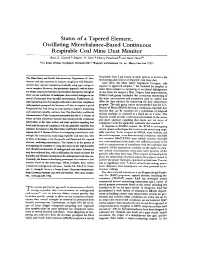Mining Publication: Status of a Tapered Element, Oscillation Microbalance-Based Continuous Respirable Coal Mine Dust Monitor
Original creation date: January 1996
The Mine Safety and Health Administration, Department of Labor, requires coal mine operators to measure compliance with federal respirable dust exposure standards periodically using approved gravimetric samplers. However, the gravimetric approach, with its inherent delays, cannot provide dust concentration data quickly enough to allow on-site correction of inadequate dust control strategies or removal of personnel from harmful environment. Furthermore, alleged tampering with dust samples collected to determine compliance with standards prompted the Secretary of Labor to appoint a special Respirable Dust Task Group to study options to improve monitoring and control of respirable coal mine dust. The Mine Safety and Health Administration's Task Group recommended that the U.S. Bureau of Mines develop a fixed-site monitor that would provide continuous information to the mine worker and mine operator regarding dust levels and the status of compliance with the applicable respirable dust standard. In response to the Mines Safety and Health Administration's response, the U.S. Bureau of Mines is investigating several sensor technologies for continuously monitoring respirable coal mine dust. One of these technologies is the Rupprecht and Patashnick Company tapered element, oscillating microbalance. The bureau is in the process of investigating the suitability of using this sensor in the high humidity and vibration environment of underground coal mines. Laboratory tests have indicated that, with modification, the sensor can meet the humidity and vibration requirements for underground coal mine use. Currently, the bureau is developing prototypes of a continuous dust monitor based on this technology. When available, these will be evaluated in underground coal mines.
Authors: BK Cantrell, SW Stein, H Patashnick, D Hassel
Peer Reviewed Journal Article - January 1996
NIOSHTIC2 Number: 20025292
Appl Occup Env Hyg 1996 Jan; 11(7):624-629
See Also
- Benchmarking Longwall Dust Control Technology and Practices
- Best Practices for Dust Control in Coal Mining
- Best Practices for Dust Control in Metal/Nonmetal Mining
- Determining the Spatial Variability of Personal Sampler Inlet Locations
- Differential Pressure Response of 25-mm-Diameter Glass Fiber Filters Challenged with Coal and Limestone Dust Mixtures
- Equivalency of a Personal Dust Monitor to the Current United States Coal Mine Respirable Dust Sampler
- Evaluation of the Approach to Respirable Quartz Exposure Control in U.S. Coal Mines
- Investigation of Coal Properties and Airborne Respirable Dust Generation
- Laboratory Testing To Quantify Dust Entrainment During Shield Advance
- Lowering Respirable Dust at an Iron Ore Concentrator Plant Through Improved Ventilation Practices
- Content source: National Institute for Occupational Safety and Health, Mining Program


 ShareCompartir
ShareCompartir
